It could perhaps happen only in Atlanta. The historians who usually gather sedately and seriously for the AHA annual meeting could be seen this time stomping their feet and swaying to the sweet sounds of the South—and joining in the singing too—during a plenary session that was given over to history presented as performance. The 121st annual meeting was remarkable also for several other firsts: the first film festival; the first time the presidential address was translated into sign language; and, on a different note, the first time a member was arrested for jaywalking in the meeting city, prompting a letter expressing concern to the mayor of Atlanta (see text of letter).
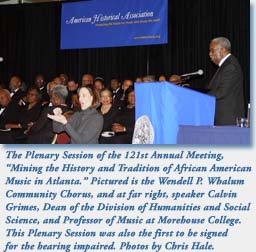 The Plenary Session
The Plenary Session
The plenary session on Thursday, January 4, 2007, was well attended, attracting several hundred historians. The evening began with the presentation of the Theodore Roosevelt-Woodrow Wilson Public Service Award to the Honorable John Lewis, representative of the 5th congressional district of Georgia. The award recognized Rep. Lewis's monumental efforts as a legislator in preserving and making available to all Americans the history of the African American experience, especially through the National Museum of African American History and Culture, which he helped to establish.
Representative Lewis could not accept the award in person because he had been called to Washington D.C., for the opening of the 110th Congress, but sent an acceptance speech on a DVD that was screened at the meeting. In his eloquent and passionate remarks, Lewis described how an interest in history inspired his own his involvement in the civil rights movement and continues to inspire his political career. Rep. Lewis noted that young people who know history know that change has happened in the past and are thus likely to be politically engaged. He charged the assembled historians that —you must never, ever give up, you must never, ever give in, you must continue to teach history, make history come alive, make it become real, not just for your students but for everyday, average Americans."
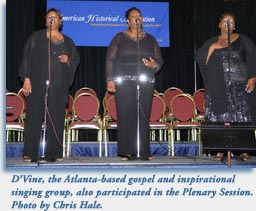
The award presentation was followed by a presentation on the evolution of African American music through the centuries. Calvin Grimes, immediate past dean of the division of the humanities and social sciences and a professor of music theory at Morehouse College, made the history of the African American musical tradition come alive by introducing the songs that were captivatingly sung (under the direction of David Morrow) by the Wendell P. Whalum Community Chorus. Grimes explained how the hymns, anthems, and arranged spirituals that the groups performed reflected development of African American music. The singers received a standing ovation for their rousing performance. The chorus was followed D'Vine, an a cappella trio, who also brought the crowd to their feet with stirring gospel music ranging from a compelling modern rendition of the traditional —Wade in the Water" to contemporary compositions commissioned by the group, including one, "Dat Ole Box," an Oliver Wells composition that was a powerfully wry commentary on modern media. D'Vine closed the evening with a rendition of "Old Landmark" that had historians in the audience clapping their hands and enthusiastically joining in the call and response sections of the song. A second standing ovation brought the energizing evening—sponsored by the Georgia Humanities Council in partnership with Morehouse College and the Rialto Center for Performing Arts—to a close. It was likely the first time members left an AHA session with a song on their lips.
The Sessions
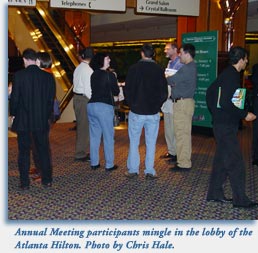 The 4,700 historians (including more than 80 scholars who came from 27 foreign countries) who attended the 121st annual meeting could choose from more than 220 sessions organized by the AHA and many that were organized by the nearly 50 affiliated societies that held their meetings in conjunction with the AHA. The sessions, roundtables, multisession workshops (all iconically signified in the newly-designed annual meeting Program) ranged from the practical—such as one of the opening workshops whose panelists provided helpful advice on how to publish one's book—to the complex and theoretical, such as one of the last sessions on Sunday, which focused attention on castrati, hermaphrodites, and other "reproductive wonders" in the 18th century.
The 4,700 historians (including more than 80 scholars who came from 27 foreign countries) who attended the 121st annual meeting could choose from more than 220 sessions organized by the AHA and many that were organized by the nearly 50 affiliated societies that held their meetings in conjunction with the AHA. The sessions, roundtables, multisession workshops (all iconically signified in the newly-designed annual meeting Program) ranged from the practical—such as one of the opening workshops whose panelists provided helpful advice on how to publish one's book—to the complex and theoretical, such as one of the last sessions on Sunday, which focused attention on castrati, hermaphrodites, and other "reproductive wonders" in the 18th century.
One session that drew a large crowd featured four distinguished historians—Eric Foner, Lynn Hunt, James McPherson, and Teofilo Ruiz—talking about their academic lives and how they came to study history. Their expositions—in which they all mentioned inspiring mentors as well as influential books and even films that moved them or shaped them—provided fascinating insights into the making of historians, pointing as much to the importance of serendipitous life changes as to unexpected shifts in intellectual choices.
Workshops, Open Forums, Breakfasts, and Other Extraordinary Sessions
T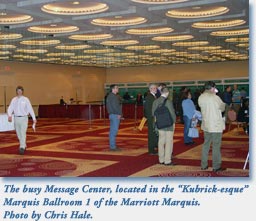 he annual meeting is not devoted only to academic sessions focusing on theoretical explorations of historical questions. It also gives considerable attention to the practical dimensions of the profession in workshops and other special sessions.
he annual meeting is not devoted only to academic sessions focusing on theoretical explorations of historical questions. It also gives considerable attention to the practical dimensions of the profession in workshops and other special sessions.
On Friday, for example, the AHA's Professional Division sponsored a "Careers in History" workshop aimed at high school, undergraduate, and beginning graduate students interested in learning more about the variety of careers for professional historians. A standing-room-only audience heard from professional historians employed in government agencies, the military, documentary editing projects, museums, archives, and historic preservation, and learned about opportunities for graduate education in public history. Presenters described the skills and experience required to find a job in their field. Long lines of students waiting to talk one-on-one with the presenters during the informal discussion period testified to the hunger for career advice among young people entering the profession.
Another Friday open forum that also drew a standing-room-only crowd with much active participation by the audience was the forum organized by the Work Group on the Future of the Association. Charged with the challenging task of developing plans for shaping the Association in the new millennium, the group was seeking answers for many questions such as the following: Why are the majority of historians are not members of the AHA? How should the AHA increase the diversity of its membership? How should the internet be used by the AHA? Are the AHR and Perspectives doing what they should be doing for members? Several members of the audience offered their responses to some of these questions.
The Professional Division hosted an Open Forum on Disability on Friday, January 5. Anthony Grafton (Princeton Univ.), the division's vice-president; Catherine Kudlick (Univ. of California at Davis), president of the Disability History Association; Paul Longmore (San Francisco State Univ.); and Rosemarie Garland Thomson (Emory Univ.) joined Grafton in leading the discussion. Conversation focused on disability history as an area of study and disability as a diversity issue. The panelists and the audience discussed ways to encourage the study of disability as a category of social identity. Participants also suggested ways to make the AHA meeting accessible to all historians. Speakers encouraged the AHA to adopt the principle of "universal design." Speakers pointed out that just as curb cuts have made city sidewalks easier for everyone to navigate, inexpensive changes to the format of the annual meeting such as encouraging speakers to describe their handouts verbally and spend more time on discussion than on the reading of formal papers will make the meeting more engaging for all historians while at the same time making the meeting more accessible for visually impaired and deaf historians. Participants also suggested that the Professional Division should compile information about accessibility issues in higher education that could be posted to help history departments find answers to questions about disability issues.
The Saturday breakfast meeting arranged by the Committee on Women's History (CWH) is, for many meeting attendees, a highlight every year. And 2007 was no exception. Welcoming the large gathering, Barbara Ransby, the chair of the CWH, reflected on the concrete gains that women historians had made over the years, thus setting the scene, as it were for the main speaker, Evelynn M. Hammonds, professor of the history of science and of African and African American studies and senior vice provost for faculty development and diversity at Harvard University. Hammonds said that she was inspired by what Alice Kessler-Harris referred to as the coalitions of the imagination (in her own talk to the CWH breakfast meeting in January 2004—see Perspectives, April 2004), and discussed the various obstacles that partly explain why feminist imaginings of inclusiveness had not been realized. Despite many studies to the contrary, Hammonds pointed out, large segments of the academic profession continued to believe in old myths about women, such as their supposed inability to do scientific research at the highest level. One of the difficulties in the way of those seeking to change the situation was the lack of data, and even the difficulties of gathering data, Hammonds said. Citing "Advance," a program that had been launched by the National Science Foundation to collect and share knowledge about gender issues, Hammonds said that while useful, it tended to exclude questions of race, whereas race and ethnicity are inextricably bound up with gender. "For me, [the term] 'women' is always inclusive, and signified all women," Hammonds declared, and pointed to what she saw as the growing gap between those who address issues of gender and those who address issues of race, a problem that she said "we must solve."
Later that day, the Professional Division sponsored an Open Forum on Public History. AHA Council member Art Gomez (National Park Service), Professional Division member Spencer Crew (National Underground Railroad Freedom Center), and public history coordinator Debbie Ann Doyle started the discussion by outlining the division's efforts on behalf of public history during the previous year. They opened the floor to suggestions regarding issues the division should focus on in 2008. Suggestions included establishing a centralized web site for students looking for internships and organizations seeking interns and consolidating the ethical standards prepared by various public history organizations and identifying ethical issues that existing standards do not address.
The General Meeting
The general meeting held on Friday is another highlight of the annual meeting, especially for the many who received prizes and honors. The capstone for the evening was the presidential address delivered by Linda K. Kerber, AHA president for 2006. In the address, which she title "The Stateless as the Citizen's Other," Kerber eloquently discussed the curious and often tragic intersections of gender and citizenship that insinuate themselves into historical constructions of otherness (for the text of the address, see the February 2007 issue of the American Historical Review).
The Business Meeting
Usually, the annual business meeting is a routine affair, at which the executive director of the Association, the vice presidents of the three divisions, the editor of the American Historical Review, and the chair of the nominating committee present reports on the activities they oversaw during the previous year. This year, the business meeting was anything but routine, and had a much larger attendance than usual mainly because the meeting considered three resolutions, at least two of which provoked considerable debate. Ultimately, after much discussion and amendments moved from the floor, the resolutions were adopted.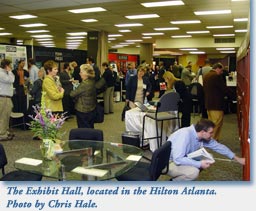
The Exhibit Hall
Ninety-eight companies exhibited their products in 150 booths this year. The majority of the companies were returning exhibitors. The exhibit hall was laid out in four different quadrants. The layout appeared a bit maze-like but "you are here" signs posted throughout the hall made it easier for attendees to find their way around. While traffic was slow in some areas, most exhibitors reported heavy traffic at their booths.
—Debbie Ann Doyle is the public history coordinator and convention assistant for the AHA. Pillarisetti Sudhir is editor of Perspectives. Kelly Elmore, the AHA's marketing manager, also contributed to this report.
Tags: Annual Meeting Annual Meeting through 2010
Comment
Please read our commenting and letters policy before submitting.






